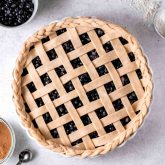
There’s nothing like the smell of a freshly baked pie. It’s my husband’s absolute favorite dessert, and in our many many years together, I have baked more pies for him than i can count: apple pie, rhubarb pie, blueberry pie, cherry pie – you name it! So today I’m going to share my go-to recipe for the best flaky pie dough, that I love to bake with.
This pie crust is everything you want in a homemade base. Unlike a tart crust, which is more buttery and crumbly, this one is light and flaky, with crisp layers that almost melt in your mouth. It’s the kind of crust you want under and over a bubbling fruity filling, and the secret to getting it just right comes down to one key detail: keeping it cold!
The most important thing when making a perfect pie dough is keeping everything cold. Cold butter is the key to that signature flaky texture. As it melts in the oven, it creates steam — which puffs up the dough and separates it into thin, delicate layers.
If your dough gets too warm while you’re working with it, you’ll lose that flakiness, and the crust can shrink — and that really sucks, especially if you’ve taken time to create a pretty lattice or decorative elements. My secret trick? I use ice water to keep the dough extra cold from the start.
What’s a Pastry Blender?
A pastry blender is a brilliant tool for making pie dough. It has a curved metal blade and a handle, making it perfect for cutting cold butter into flour. It’s faster, cleaner, and keeps your hands from heating your dough.



We all dream of that golden, crisp crust — here’s how to get it! Start with a hot oven to help the crust set and get color. Then turn the heat down to finish baking the filling and bottom crust evenly. For most pies, I bake at 200°C (400°F) for 15–20 minutes, then lower to 180°C (350°F) and bake for another 25–30 minutes, until the filling bubbles and the crust is deeply golden.
Use a metal or glass pie dish for best results. Ceramic dishes work too but may need a bit more baking time.

Frequently Asked Questions
Can I use vegan butter?
Yes! Just use a firm vegan block, not spreadable butter from a tub. The dough may be a bit more delicate and need longer chilling, but the results are still great.Can I use this dough for savory pies or quiche?
This dough is slightly sweet and very buttery, so it’s best for dessert pies. For savory pies, I recommend using a more neutral shortcrust instead.How do I prevent the crust from shrinking?
Keep everything cold and avoid stretching the dough in the pan. Chill the final pie before baking.How long does the dough keep?
This dough keeps in the fridge for up to 3 days and in the freezer for up to 3 months. You can also freeze a fully assembled unbaked pie and bake it straight from frozen.


Hi, I’m Trine – home baker from Copenhagen, Denmark. “Bageglad” means happy to bake in Danish and I have been spreading this happiness on the blog since 2012. Today, it reaches more home bakers worldwide than I could ever have dreamed of! Thank you for visiting!

Hi, I’m Trine – home baker from Copenhagen, Denmark. “Bageglad” means happy to bake in Danish and I have been spreading this happiness on the blog since 2012. Today, it reaches more home bakers worldwide than I could ever have dreamed of! Thank you for visiting!